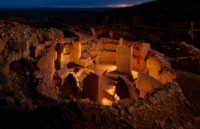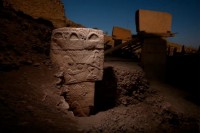Neolithic Revolution
Description
 |
The Neolithic Revolution was viewed as a single event—a sudden flash of genius—that occurred in a single location, Mesopotamia, between the Tigris and Euphrates Rivers in what is now southern Iraq, specifically the site of a realm known as Sumer, which dates back to about 4000 B.C.E. It then spread to India, Europe, and beyond. Most archaeologists believed this sudden blossoming of civilization was driven largely by environmental changes: a gradual warming as the Ice Age ended that allowed some people to begin cultivating plants and herding animals in abundance.
Agriculture
One part of humankind turned its back on foraging and embraced agriculture. The adoption of farming brought with it further transformations. To tend their fields, people had to stop wandering and move into permanent villages, where they developed new tools and created pottery.
For thousands of years men and women with stone implements had wandered the landscape, cutting off heads of wild grain and taking them home. Even though these people may have tended and protected their grain patches, the plants they watched over were still wild. Wild wheat and barley, unlike their domesticated versions, shatter when they are ripe—the kernels easily break off the plant and fall to the ground, making them next to impossible to harvest when fully ripe. Genetically speaking, true grain agriculture began only when people planted large new areas with mutated plants that did not shatter at maturity, creating fields of domesticated wheat and barley that, so to speak, waited for farmers to harvest them.
Rather than having to comb through the landscape for food, people could now grow as much as they needed and where they needed it, so they could live together in larger groups. As the population quickly increased, ideas could be more readily exchanged, and rates of technological and social innovation soared. Religion and art—the hallmarks of civilization—flourished.
Natufians
In the Levant—the area that today encompasses Israel, the Palestinian territories, Lebanon, Jordan, and western Syria—archaeologists had discovered settlements dating as far back as 13,000 B.C.E. Known as Natufian villages (the name comes from the first of these sites to be found), they sprang up across the Levant as the Ice Age was drawing to a close, ushering in a time when the region's climate became relatively warm and wet.
Although the Natufians lived in permanent settlements of up to several hundred people, they were foragers, not farmers, hunting gazelles and gathering wild rye, barley, and wheat. Natufian villages ran into hard times around 10,800 B.C.E., when regional temperatures abruptly fell some 12°F, part of a mini ice age that lasted 1,200 years and created much drier conditions across the Fertile Crescent. With animal habitat and grain patches shrinking, a number of villages suddenly became too populous for the local food supply. Many people once again became wandering foragers, searching the landscape for remaining food sources.
Some settlements tried to adjust to the more arid conditions by cultivating local stands of rye, perhaps replanting them. Rye grains were bigger than their wild equivalents—a possible sign of domestication, because cultivation inevitably increases qualities, such as fruit and seed size, that people find valuable.
The Natufian protovillages in the Levant suggested that settlement came first and that farming arose later, as a result of crisis. Confronted with a drying, cooling environment and growing populations, humans in the remaining relatively fertile areas stayed where they were and subsisted, developing agriculture in the process.
New Evidence
 |
This change in consciousness was a "revolution of symbols," a conceptual shift that allowed humans to imagine gods—supernatural beings resembling humans—that existed in a universe beyond the physical world. The animal figures at Göbekli Tepe could have been guardians to the spirit world.
It is possible that foragers living within a hundred-mile radius of Göbekli Tepe created the temple as a holy place to gather and meet, perhaps bringing gifts and tributes to its priests and craftspeople. Some kind of social organization would have been necessary not only to build it but also to deal with the crowds it attracted. One imagines chanting and drumming, the animals on the great pillars seeming to move in flickering torchlight. Surely there were feasts, and stone basins have been uncovered that could have been used for beer.
Crisis-Driven Change
The need to acquire sufficient food for those who worked and gathered for ceremonies at Göbekli Tepe may have led to the intensive cultivation of wild cereals and the creation of some of the first domestic strains. Indeed, scientists now believe that one center of agriculture arose in southern Turkey—well within trekking distance of Göbekli Tepe—at exactly the time the temple was at its height. Today the closest known wild ancestors of modern einkorn wheat are found on the slopes of Karaca Dag, a mountain just 60 miles northeast of Göbekli Tepe.
Some of the first evidence for plant domestication comes from Nevali Çori (pronounced nuh-vah-LUH CHO-ree), a settlement in the mountains scarcely 20 miles away. Like Göbekli Tepe, Nevali Çori came into existence right after the mini ice age, a time archaeologists describe with the unlovely term Pre-pottery Neolithic (PPN). Nevali Çori is now inundated by a recently created lake that provides electricity and irrigation water for the region. But before the waters shut down research, archaeologists found T-shaped pillars and animal images much like those uncovered at Göbekli Tepe. Similar pillars and images occurred in PPN settlements up to a hundred miles from Göbekli Tepe. Much as one can surmise today that homes with images of the Virgin Mary belong to Christians, the imagery in these PPN sites indicates a shared religion—a community of faith that surrounded Göbekli Tepe and may have been the world's first truly large religious grouping.
Multiple Hypotheses
The lack of evidence of houses doesn't prove that nobody lived at Göbekli Tepe. And increasingly, archaeologists studying the origins of civilization in the Fertile Crescent are suspicious of any attempt to find a one-size-fits-all scenario, to single out one primary trigger. It is more as if the occupants of various archaeological sites were all playing with the building blocks of civilization, looking for combinations that worked. In one place agriculture may have been the foundation; in another, art and religion; and over there, population pressures or social organization and hierarchy. Eventually they all ended up in the same place. Perhaps there is no single path to civilization; instead it was arrived at by different means in different places. Not long ago, the prevailing hypothesis was that civilization was driven by ecological forces. The new evidence suggests that civilization is a product of the human mind.
Excerpted and adapted from: Mann, Charles C. 2011. The Birth of Religion. National Geographic Magazine 219(6):34-59.
See also: The Birth of Religion